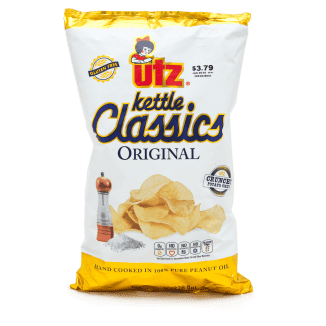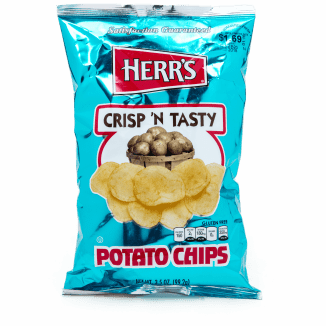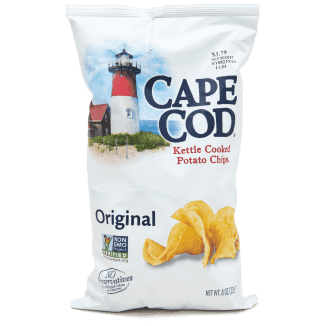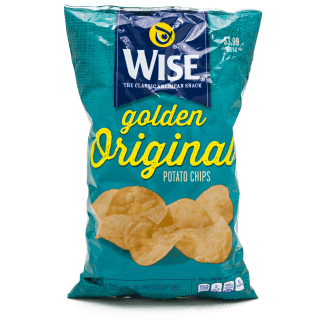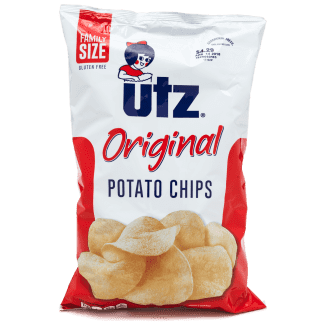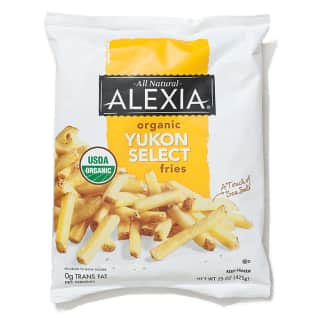Potato chips were invented in America and remain one of the country’s favorite snacks. Last year, we spent $7.3 billion on them—considerably more than we spent on pretzels, corn chips, or popcorn. So which potato chip is the best? A few years ago, we decided that it was thick, salty kettle-cooked chips, but behind the scenes, the debate raged on. We decided to settle it the only way we know how: Resurvey the options and hold a new blind tasting. Using data from a market research firm, we identified nine top-selling, nationally available potato chips and purchased each in its simplest salted flavor. Our lineup included four “regular” chips and five thick “kettle-style” chips, priced from $0.31 to $0.61 per ounce. We focused on one core evaluation: sampling the chips plain. Our tasters rated each chip’s flavor, texture, and saltiness, as well as its overall appeal. After forming our rankings, we held an additional test, asking participants to drag the chips through creamy French onion dip and eat them. This helped us gauge the chips’ sturdiness and compatibility with thick, flavorful dips.

Regular And Kettle Chips: What’s The Difference?
All the products in our lineup contain just potatoes, oil, and salt, yet there were noticeable flavor and texture differences among them. We knew that processing played a role; to find out more, we spoke with Molly Mancini, the innovation manager for Utz, a Pennsylvania-based snack company that manufactures potato chips in a variety of styles under several brand names, such as Zapp’s and Dirty Chips. Like us, she identified two main styles: thin, delicate chips (which she calls “regular”) and thick kettle-style chips.
Making regular potato chips is a fully automated, nonstop process called a “continuous fry.” The potatoes essentially “go from raw to finished chips in one fell swoop,” Mancini said. Raw potatoes are placed on conveyor belts and quickly washed, peeled, sliced, fried, and packaged. Belts even propel the potatoes through the fryers, and there’s no stopping to change the oil, which is automatically replenished.
Kettle chips are made similarly, with one big difference: They’re fried in batches in big vats. Because they’re not propelled through the oil, they must be agitated, either with a rake-like device or with an automatic stirrer, to ensure that they cook evenly and don’t clump.

Crispy Vs. Crunchy
When we looked at our tasting results, we saw a clear pattern. Again and again, tasters described kettle chips as “crunchy” and regular chips as “crispy.” Both terms refer to the sound foods make when you bite into and chew them. Some experts argue that they refer to the same textural quality, but there’s also research suggesting that “crispy” and “crunchy” are two distinct eating experiences.
A single folded or crumpled chip is often as much as 13 millimeters thick. That’s a lot of crunch.
There’s a very simple reason that kettle chips seem crunchier: They’re generally sliced thicker. We measured 25 chips at random from each bag and found the kettle chips to be about 50 percent thicker than regular chips, on average: 1.56 millimeters versus 1.07 millimeters. Because they’re stirred during the frying process, kettle chips are also more likely to fold over or become cupped. When you take into account the layers of folded chips, the difference in thickness is much greater. A single folded or crumpled chip is often as much as 13 millimeters thick. That’s a lot of crunch.
The frying process also contributes to the crispy-crunchy distinction between regular and kettle chips. As Harold McGee explains in On Food and Cooking (2004), sliced potatoes undergo chemical changes when they are fried. Regular chips are fried at a high, consistent temperature (about 350 degrees) for just 3 to 4 minutes, which means that the starches and moisture in the potatoes don’t have time to interact. According to McGee, the chips are “delicately crisp and fine-grained” as a result. Kettle chips require 8 to 10 minutes in the fryer. In that time, the moisture and starch granules combine. The starch begins to dissolve and forms a sticky gel that essentially glues the potato’s cell walls together. According to McGee, this gives kettle chips their characteristic hard, crunchy quality.


Did Oil And Salt Matter?
We were curious if the frying stage affected flavor, too, so we looked at the types of oil used.
Our winning chip was fried in 100 percent peanut oil and tasted especially rich and “potato-y.” Most of the others were fried in a blend of oils such as sunflower, safflower, and canola, and tasters didn’t notice any meaningful flavor differences among them.
Fat and salt didn’t seem to play a major role in our rankings. Chips ranged from 7 to 10 grams of fat and from 90 to 180 milligrams sodium per serving, and there were no strong trends. Though we generally preferred chips with at least 120 milligrams of sodium, there were exceptions: One chip with that much sodium tasted bland, and another with just 90 milligrams was acceptable. Mancini explained that this could be due to the size of the salt particles, as coarse salt “creates a different type of crunch and mouthfeel” than fine salt, “which melts right away.”

Picking Our Favorites
Given all we’d learned about kettle chips and regular chips, we weren’t surprised that our tasters could tell them apart and generally preferred one style to the other. Still, we recognized the good and the bad in each style. One regular chip was so thin that it felt “wispy,” and two kettle chips were crunchy to the point of being “hard.” The rest of our lineup ranged from good to great.

Our overall top scorer was a kettle chip, but a regular chip was close on its heels. We think they’re ideal representatives of their styles, and we enthusiastically recommend both. The “beautiful crunch and great salt balance” of Utz Kettle Classics, Original ($0.47 per ounce) had tasters declaring, “I love these chips.” Meanwhile, our favorite regular chips, Herr’s Crisp ’N Tasty Potato Chips ($0.31 per ounce) were “totally traditional” and “delicate” but not frail or flimsy—they even held up to thick, creamy French onion dip. If you want to make everyone happy—or inspire a heated debate—we recommend buying both.
Reduced Fat, Full Flavor
Our favorite chip, Utz Kettle Classic, comes in a reduced-fat version with 40 percent less fat. In a side-by-side blind tasting, our tasters were impressed. Like our winner, the reduced-fat chips were “nice and crunchy” and had “satisfying” salty, potato-y flavor. While tasters described them as noticeably “drier” and less greasy, they were quick to point out that they were “not too health food-y.” In fact, some tasters even preferred the reduced-fat version.
How was Utz able to pull off a reduced-fat chip that doesn’t taste reduced-fat? For starters, they’re actually fried slices of potato. (Some reduced-fat chips are baked and made by combining sugar, binders, and leaveners with dehydrated potatoes to form a dough that’s cut into “chips” and baked.) The process is nearly identical to the classic chips, with an additional step: After they’re removed from the fryer, excess oil is spun off in a centrifuge. Molly Mancini, the innovation manager for Utz, told us that it works “like a washing machine,” but instead of shedding water, the spin cycle works by “removing a few grams of fat or oil from the chips.” Since the chips are still warm and soft from the fryer, they can withstand the spinning without breaking or crumbling. No wonder they tasted so similar to the full-fat version.
- Contains at least 120 milligrams of sodium per serving, for flavorful and well-seasoned chips
- Rich flavor but not greasy
- Satisfyingly crunchy or crispy texture
- For kettle chips: 1.3 to 1.59 millimeters thick on average, for chips that are crunchy but not too hard
- For regular chips: 1.06 to 1.13 millimeters thick on average, for chips that are thin and delicate but not flimsy
- Taste plain, from freshly opened packages
- Compare nutritional information and ingredients
- Select 25 chips at random from each bag, then calculate average weight and thickness
- Count number of folded chips in 25‑chip sample
- Ask panel of testers to evaluate chips with creamy French onion dip

